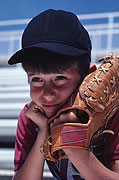- Skip Storing This Everyday Product in the Fridge Door
- Green Tea + B3 Pairing May Boost Brain Health
- Navigating Your Midlife Crisis: Embracing New Possibilities
- City Raccoons Showing Signs of Domestication
- Mapping the Exposome: Science Broadens Focus to Environmental Disease Triggers
- One Week Less on Social Media Linked to Better Mental Health
- Your Brain Changes in Stages as You Age, Study Finds
- Some Suicide Victims Show No Typical Warning Signs, Study Finds
- ByHeart Formula Faces Lawsuits After Babies Sickened With Botulism
- Switch to Vegan Diet Could Cut Your Greenhouse Gas Emissions in Half
‘Little League Shoulder’ on the Rise


With summer in full swing so too are youthful arms, with kids happily throwing pitches as hard and as fast as they can on baseball diamonds all across America.
But experts warn that some children who engage in repetitive overhead ball-throwing — especially pitching — can end up paying a price, as insufficient strength paired with poor form turns into the condition commonly known as “Little League shoulder.”
The condition causes an unwelcome combination of shoulder pain, swelling and impaired mobility. It also appears to be on the rise.
“It’s certainly being seen with more frequency,” said study author Dr. Benton Heyworth, an instructor of orthopaedic surgery at Harvard Medical School, and a practitioner in the division of sports medicine at Boston Children’s Hospital. “And that’s likely due to trends in youth sports in general.
“In the case of baseball, that means more year-round pitching without the appropriate period of rest between, and more pitching at higher velocities. Which means that although ‘USA Baseball’ and ‘Little League Baseball’ outline clear pitch-count limits, what we’re seeing are very straightforward overuse injuries that come from kids simply pitching too much,” Heyworth added.
Doctors are also seeing shoulder injuries in catchers and position players in baseball, as well as in girls and tennis players, too, Heyworth said.
He and his colleagues presented their findings recently at the American Orthopaedic Society for Sports Medicine’s annual meeting in Seattle.
To gain more insight into Little League shoulder, the investigators analyzed the experience of 95 patients with the condition aged 8 to 17 (the average age was 13).
All were treated at a single pediatric care facility between 1999 and 2013, and nearly all (97 percent) were baseball players. Of those, 86 percent were pitchers, 8 percent were catchers, and 7 percent played other positions.
Three percent of the group were tennis players. Just two out of the 95 were female, according to the study.
In addition to the main issue of shoulder pain, 13 percent of the patients also complained of elbow pain, while 10 percent said they suffered from shoulder weakness and/or fatigue. Nearly as many (8 percent) said they experienced mechanical difficulties with shoulder movement.
About one-third of the players were found to have developed reduced range-of-motion. And those who had range-of-motion issues faced a three times greater risk that their Little League shoulder would end up recurring within six to 12 months following their return to sports, the findings showed.
Shoulder rest was the key treatment in 98 percent of cases. On average, it took players more than four months to return to play and more than 2.5 months to experience symptom relief, although more than 7 percent had the shoulder problem recur during the following eight months, the researchers said.
Physical therapy was also part of the treatment package for 79 percent of patients, overall, and for all of those with range-of-motion problems. One-quarter of the patients were also told to change positions once they got back on the field, the study authors noted.
“The hallmark of treatment is rest,” Heyworth reiterated. “And we recommend a period of training — and maybe even physical therapy — even after rest before return to play, particularly because the 7 percent recurrence rate may be an underestimate because a lot of these kids underreport pain,” he explained.
“But the larger view is that youth sports injuries continue to become more prevalent,” Heyworth added. “And the best way to treat them is actually to prevent them, because this is a very preventable condition. Certainly when it comes to pitching, there needs to be adequate periods of rest, and adherence to well-established pitch-count limits.”
However, Dr. Lewis Maharam, a sports medicine specialist in private practice in New York City, and past president of the New York chapter of the American College of Sports Medicine, disputes that pitch counts are a problem.
“There are certainly always kids that are being over-pushed,” he acknowledged. “There’s always the risk of stage parents that want their kids to be top of the line and encourage them to go outside the guidelines. But I firmly believe that Little League protocol takes care that players don’t blow out their arms from overuse,” said Maharam. “They have had pitching limits in place for at least 30 years.”
Maharam advised that “parents should make sure that their coach and team officials are following the Little League protocol. And if they want their kids to be the best they can be, they should find a physical therapist and athletic trainer that has expertise in strength and flexibility training, so their kids are prepared for the sport.”
More information
Read more about throwing injuries to the shoulder from the American Academy of Orthopaedic Surgeons.
Source: HealthDay
Copyright © 2025 HealthDay. All rights reserved.










